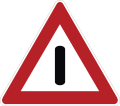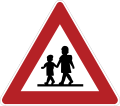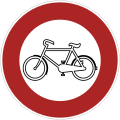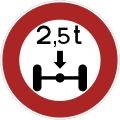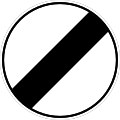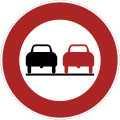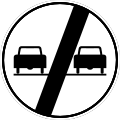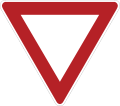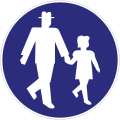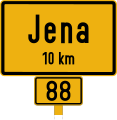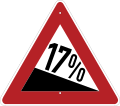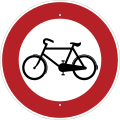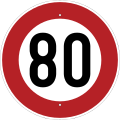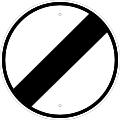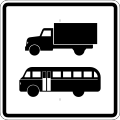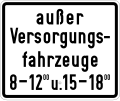
Traffic signs with the signs introduced in 1964 according to Fig. 46 c (petrol station), Fig. 47 (main road) and Fig. 27 (no left turns) in 1968 in
Riesa

At Alexanderplatz in
Berlin , the newly introduced traffic light for pedestrian protection routes according to Fig. 59 was also in operation in 1964. In the background you can still see the older version of Fig. 36 a, introduced in 1956 (note the right of way for the tram!).

GDR stamp series "Safety in Road Traffic"; here with the stamp published in 1969 that shows picture 18
The picture table of the traffic signs in the German Democratic Republic from 1964 to 1971 shows the traffic signs in the German Democratic Republic (GDR) as they are by the Road Traffic Act (StVO) of January 30, 1964 as a regulation on behavior in road traffic (road traffic Regulation - StVO -) have been introduced by the Council of Ministers of the GDR . The traffic signs of the StVO from 1964 already underwent extensive visual changes with the entry into force of the GDR standard Technical Norms, Quality Regulations and Delivery Conditions (TGL) number 10629, which came into force on January 1, 1968. Due to the additional additions to the traffic signs made in the TGL, the sign manufacturers now had a wide range of variants available. However, these additions were not included in the road traffic regulations until a new StVO was introduced on January 1, 1978. The 1971 amendment to the Road Traffic Act also brought major changes and is therefore dealt with in a separate article.
With the new version of the Road Traffic Regulations of 1964, current international road traffic regulations found their way into the GDR traffic sign catalog. In addition, the country's armed forces were able to intervene in traffic management within the framework of the road traffic regulations. In addition, road traffic-relevant signs or signals of the ordinances on the construction and operation of trams (BOStrab) are reproduced in this table .
Important innovations
In particular with the regulation of a number of new traffic signs on the subject of parking, those responsible wanted to react to the increasing individual traffic. In the mid-1960s, the GDR car industry at the Zwickau and Eisenach locations had exceeded the 1938 production output. But even at this point in time, the relationship between supply and demand was clearly disproportionate, and this increased further and further. Real, unlimited parking problems existed in the times of the GDR only in a few significant places. As a result, the setting up of the traffic signs in Fig. 44 a to g was usually limited to urban centers.
With the new StVO, the military , barracked units of the Ministry of the Interior and combat groups could now also close crossings on three sides. The corresponding armband of the regulatory post provided by the armed organs of the GDR was listed as picture 63 in the road traffic regulations. The armband remained part of the uniform of regulatory posts, but it disappeared from the StVO in 1971. The blocking options for armed units remained part of the traffic regulations.
In the Federal Republic of Germany , the 1956 StVO amendment dealt with the improved safety of pedestrian crossings. For this purpose, a flashing light to be set up on both sides of the street was arranged, but was used very sparingly for various reasons. As a result, this flashing light disappeared again from West German traffic on June 1, 1964. At this point in time, the new version of the GDR StVO from 1964 had already followed suit with its own yellow and black traffic light for the crossings called "pedestrian protection path" here. But it too was withdrawn from circulation with the new road traffic regulations announced in 1977.
Colours
In order to break away from the standards such as RAL and DIN, which were continued in West Germany after the war and to emphasize the independence of the GDR, one of the country's major projects was to introduce new industrial standards. The mass of old standards that had to be redefined, as well as the constantly changing requirements due to innovations in research and technology, made this work a Sisyphean work . In the GDR, the DIN standards were compared with the TGL standard ( technical standards, quality regulations and delivery conditions ) for the first time from 1955 . When the new StVO was introduced in 1964, the type color card 5/62 was the first GDR-specific color standard to appear in 1962. But it was only with the mandatory requirements of the TGL 10629 (guidance systems for road traffic), which were introduced on January 1, 1968, that all the basic standards relating to traffic signs were covered for the first time. As a replacement for the older standard TGL 0-6163 from November 1962, the standard TGL 20684, sheet 6, published in February 1967 (signal lights - colors and color boundaries in traffic - stationary signal lights in road traffic) defined the color boundaries. In January 1969 the color tones were again regulated by TGL 21196 (paints - color register). The basic colors for the traffic signs of the StVO were only defined with the unspecific designations red, yellow, blue etc. With these basic colors, the desired color spectrum could be defined using the TGL 20684 and the CIE standard color chart reproduced there , and the closest color could be selected from the type color card.
- Red - TGL 21196 (1969): 0605 "Signalrot" = Lab L 44.78, a 50.80, b 26.62 (= RAL color register 840 R: 3000)
- Yellow - TGL 21196 (1969): 0209 "Chrome yellow" = Lab L 76.81, a 9.08, b 67.66 (= RAL color register 840 R: 1004)
- Blue - TGL 21196 (1969): 1464 "Ultramarine" = Lab L 37.22, a 8.32, b −27.81 (= no equivalent in RAL)
The perceptible spectrum in the 1976 CIE-Lab color space is given by TGL 21196, which came into effect on March 1, 1988. Although this last-mentioned TGL was created long after the StVO came out of force in 1964, the TGL color values were first brought into a form that could be used by image processing programs. So the color values could also be used for the illustrations in this article.
Fonts

Bold middle letters according to TGL 0-1451
Since the introduction of the TGL 0-1451, which became binding on January 1, 1963, those responsible in the GDR had also prescribed their own font standard for traffic signs. The TGL specifications were based directly on the pre-war standard of DIN 1451 and were borrowed from this design language. As with the DIN font weights, there were also narrow, medium and wide fonts, with print types in different font weights . Practice has shown that even official images in the legal texts or other publications did not adhere to these specifications and instead many variations of the DIN script were used, as was already common practice with sign painters before the war. This was not an East German phenomenon, but could also be observed in West Germany at the same time. It was not until the beginning of the 1970s, with the advent of electronic control systems for the production of traffic signs, that the uniformity of the lettering that we know today became established. The TGL-0-1451 gives clear guidelines for the cone and font sizes of the print types. Great importance was attached to good kerning and appropriate line spacing . All of this should increase the legibility of the road signs.
Manufacturing
With the TGL 10629, announced on April 10, 1967 and binding on January 1, 1968, standardized drill holes were made mandatory in traffic signs. The illustrations on this page show these drill holes at the precisely defined locations. Only the signs used on motorways could be produced without perforation. Signs made of sheet steel were to be designed with a bead . Sheet steel signs that had to be renewed should be replaced by aluminum or " plastic " signs . According to this standard, the manufacturer's company with address, month and year of manufacture had to be weatherproof on the back.
I. Warning signs
Fig. 1
General danger point
Fig. 4 c
double curve starting to the right
Fig. 4 d
double curve starting to the left
Fig. 7
Narrowing of the roadway
Fig. 8
Crossing for pedestrians
Figure 9a
Flight operations -
in conjunction with a red flashing
light (TGL 10629)
Fig. 11
Barricaded level crossing
Fig. 12
Unrestricted level crossing
Fig. 13
Three-lane beacon (restricted to the left 240 m before the level crossing)
Fig. 13 a
Three-lane beacon (unrestricted right 240 m before the level crossing)
Fig. 14
Two-lane beacon (left 160 m before the level crossing)
Fig. 15
Single lane beacon (right 80 m before the level crossing)
Fig. 16
Gated level crossing
Fig. 17
Unrestricted level crossing (single track)
Figure 17 a
Unrestricted level crossing (single track with stop lights)
Fig. 18
Unrestricted level crossing (multi-track)
Fig. 18 a
Unrestricted level crossing - electrified line - single track (note clearance height)
II. Prohibition signs
Fig. 19
Traffic ban for vehicles of all kinds
Fig. 19 a
Traffic ban for through traffic
Fig. 19 b
Traffic ban for vehicles of all kinds (residents free)
Fig. 20
Prohibition of one direction of travel or entry
Fig. 21
Traffic ban for motor vehicles
Fig. 22
Traffic ban for motorcycles
Fig. 23
Traffic ban for cars and motorcycles
Fig. 24
Traffic ban for cyclists
Fig. 25
Traffic ban for vehicles on Sundays and public holidays
Figure 25
Instead of Figure 25, Figure 22 can also be used accordingly
Figure 25
Instead of Figure 25, Figure 24 can also be used accordingly
Fig. 26
Traffic ban for trailer vehicles
Figure 27
prohibited left turn
Fig. 28
Right turns prohibited
Fig. 31
Traffic ban for vehicles over a certain width
Fig. 32
Traffic ban for vehicles over a certain height
Fig. 33
Traffic ban for vehicles over a certain total weight
Fig. 33 a
Traffic ban for vehicles over a certain axle load
Fig. 34
Speed limit in km / h
Fig. 34 a
End of the speed limit
Fig. 35
No overtaking for multi-lane vehicles among each other
Fig. 35 a
End of the ban on overtaking for multi-lane vehicles
Fig. 36
Pay attention to the right of way on the main road
Fig. 36 a
Note the right of way for the tram
37
Stop! Pay attention to the right of way on the main road!
III. Mandatory sign
Fig. 39
Use only permitted in the direction of the arrow
Fig. 44 a
Parking lot for taxi vehicles only
Fig. 44 b
Parking arrangement perpendicular to the direction of travel
Fig. 44 c
Parking arrangement at an angle to the direction of travel
Fig. 44 d
Parking arrangement on the sidewalk
Fig. 44 e
Parking arrangement halfway on the sidewalk
Fig. 44 f
Parking arrangement on the sidewalk across the direction of travel
Fig. 44 g
Parking arrangement halfway on the sidewalk perpendicular to the direction of travel
IV. Signs
Fig. 46 a
Telephone station
Fig. 46 b
Roadside assistance
Fig. 47
Signs for the main road
Fig. 47 a
main road turning (left)
Fig. 47 a
Right of way of the turning main road
Fig. 48
"Beginning" expressway
Fig. 48 a
"End" expressway
Fig. 49
License plate for trunk roads
Fig. 50
Signposts for trunk roads
Fig. 51
Signposts for other paved roads
Fig. 51 a
Signpost to the motorway
Fig. 51 b
Signpost for transit traffic
Fig. 52
Signposts for unpaved roads
Fig. 53
Place-name sign (front)
Fig. 53 a
Place-name sign (rear)
Fig. 54 a
Signpost before road crossings and branches
Fig. 54 b
Signposts in front of intersections and junctions
Fig. 54 c
Signposts in front of intersections and junctions
Fig. 54 d
Signposts in front of intersections and junctions
Fig. 54 e
Signposts in front of intersections and branches
Fig. 54 f
Signposts in front of intersections and branches
V. Traffic control systems
Fig. 55
Board for rerouting traffic to trunk roads or roads l. and ll. order
Fig. 56
Signpost along the diversion route
Fig. 57
Sign for directing traffic when the road is closed on one side
Fig. 58
Locking device in front of construction sites (without lighting)
Fig. 59
Traffic light for pedestrian protection path
Fig. 60
Traffic divider (illuminated mushroom)
Figure 60 a
traffic divider (light column)
Fig. 60 b
Traffic control and shut-off cone
Fig. 61
Trowel for wagon drivers
Fig. 62
Warning flag "Attention, risk of slipping" (arrangement in the event of sudden slippery snow or ice, traces of oil, etc.)
Fig. 63
Armlet for adjustment items
Guiding stones and guide pegs
The provisions of the provisional guidelines for the expansion of rural roads (RAL 1937) from December 1942 continued to apply in the GDR. They were only slightly modified in terms of text, as confirmed in the textbook Routing in Road Construction from March 1956.
Guiding stones
according to panel VIII of RAL 1937 from December 1942
Guidepost
in the identical design for both West Germany and the GDR
Stop signs for trams and motor vehicle lines
The signs stop for trams and stop for motor vehicles not contained in the StVO were originally published in the Reichsverkehrsblatt (RVkBl) in 1939, but were not included in the road traffic regulations. The ordinance from the Reichsverkehrsblatt with the stop signs for trams contained therein remained unaffected by the new ordinance on the construction and operation of trams (BOStrab) of December 8, 1959, which came into force on April 1, 1960 . The new BOStrab only repealed the previous ordinance from 1937. In its facilities, the BOStrab confirmed the previous stop signs for trams from 1959. The stop sign for motor vehicle lines continued to apply in its familiar form. In the 1960s, however, new signs for bus stops were also introduced.
Signal St 1
(BOStrab 1958)
Stop
signs for trams (RVkBl 1939)
old sign:
stop sign for motor vehicle lines
(RVkBl 1939)
new sign:
stop sign for motor vehicle lines
Signal St 3
(BOStrab 1958)
double
stop (RVkBl 1939)
Highway sign
At this time, the motorway signs were not yet part of the road traffic regulations and were regulated separately.
Announcement board at the end of the autobahn in front of the Eisenach-Kirchheim route, which was not completed by 1945 (1968)
Subsequent changes and additions to the traffic signs
1965
In addition to the information on the regulatory items contained in the StVO of 1964, to which Figure 63 belonged, the First Implementing Provision for Road Traffic Regulations (StVO) followed on May 7, 1965 . Here precise information on traffic regulation by the armed organs of the GDR was written down. This implementation regulation expired on August 1, 1971.
1967
The guidance systems for road traffic introduced in June 1966 according to the then defined TGL 12096 were not included in the road traffic regulations. The guide hatches prescribed in the TGL could be applied to signs or to the obstacles themselves. A distinction was made between yellow and black hatching on permanent obstacles such as bridge piers, parapets and rocks, and red and black hatching on shut-off devices, vehicles and work equipment. The TGL 12 096 became binding on April 1, 1967.
Fig. 4
Guide hatching on permanent obstacles
Fig. 4
Guide hatching on permanent obstacles
Figure 5
Guide hatching on permanent obstacles
Fig. 6
Guide hatching on permanent obstacles
for Fig. 4
Guide hatching on non-permanent obstacles
Fig. 4
Guide hatching on non-permanent obstacles
Figure 5
Guide hatching on non-permanent obstacles
Figure 6
Guide hatching on non-permanent obstacles
The TGL defines an exception for white-red hatchings, in addition to their otherwise non-permanent use in the street area: their use with shut-off devices that were constantly on the road. Since the 1960s, the guiding stones have also appeared with a red and white paint. As stated in the West German ÖTV press , the central organ of the public services, transport and traffic union in 1954, natural stones that were too dark should be painted light. A similar rule may have applied in the GDR, as there, too, guiding stones were sometimes given a white shaft.
1968

Fig. 29 of the TGL 10 629 with the prescribed drill holes in 1968. Despite specifications that were precise to the centimeter, there were sometimes significant deviations in the designs.
With the TGL 10 629 (guidance systems for road traffic - traffic signs - signs), which came into force on January 1, 1968, the traffic signs underwent extensive visual changes and multiple additions that were not included in the road traffic regulations, but the Nonetheless, they gave sign manufacturers important pointers for a more comprehensive sign design. A correct representation of the traffic signs is only possible in connection with the TGL 10 629, sheet 3 (guidance devices for road traffic - traffic signs - symbols, color, writing) and the TGL 20 684, sheet 6 (signal lights - colors and color borders in traffic - fixed signal lights in traffic) possible. Both standards, like TGL 10 629, became binding on January 1, 1968. The standardized drill holes in the sign according to TGL 10 629, Table 2, are required by the authorities and are therefore an indispensable part of these traffic signs and are therefore shown in the illustration. When the TGL 10 629 was introduced, the type color card 5/62 was still used, and from October 1, 1969, the binding color card according to TGL 21 196 (TGL 21 196 from January 1969, paints - color register). The symbols reproduced here strictly adhere to the specifications of the TGL. In reality there could be deviations. Some of the symbols shown here were only valid in this form for around two and a half years before some new symbols were added in August 1971, others were given new design specifications and others were abolished.
Figure 1
General danger point
(TGL 10 629, sheet 3, p. 11)
Fig. 2
Cross channel
(TGL 10 629, sheet 3, p. 11)
Fig. 3
Hauptstraße
(TGL 10 629, sheet 3, p. 12)
Fig. 4
Crossing
(TGL 10 629, sheet 3, p. 12)
Fig. 4 a
right-hand bend
(TGL 10 629, sheet 3, p. 12)
Fig. 4 b
left turn
(TGL 10 629, sheet 3, p. 12)
Fig. 4 c
double curve starting to the right
(TGL 10 629, sheet 3, p. 12)
Fig. 4 d
double curve starting to the left
(TGL 10 629, sheet 3, p. 12)
Fig. 5
Heavy slope
(TGL 10 629, sheet 3, p. 13)
Fig. 5 V
steep gradient
(TGL 10 629, sheet 3, p. 13)
Fig. 6
Danger of skidding
(TGL 10 629, sheet 3, p. 13)
Fig. 7
Narrowing of the roadway
(TGL 10 629, sheet 3, p. 13)
Fig. 8
Crossing for pedestrians
(TGL 10 629, sheet 3, p. 13)
Fig. 9
Construction site
(TGL 10 629, sheet 3, p. 13)
Fig. 9 a
Flight operations
(TGL 10 629, sheet 3, p. 14)
Figure 10
Children
(TGL 10 629, sheet 3, p. 14)
Figure 10 a
Deer crossing
(TGL 10 629, sheet 3, p. 14)
Fig. 11
Barrier level crossing
(TGL 10 629, sheet 3, p. 14)
Fig. 12
Unrestricted level crossing
(TGL 10 629, sheet 3, p. 14)
Fig. 13
Three-lined beacon
(TGL 10 629, sheet 3, p. 14)
Fig. 13 a
Three-lined beacon
(TGL 10 629, sheet 3, p. 14)
Fig. 13 V
Three-striped beacon
(TGL 10 629, sheet 3, p. 15)
Fig. 14
Two-lined beacon
(TGL 10 629, sheet 3, p. 15)
Fig. 14 a
Two-lined beacon
(TGL 10 629, sheet 3, p. 15)
Fig. 14 V
Two-lined beacon
(TGL 10 629, sheet 3, p. 15)
Fig. 15
Single-lined beacon
(TGL 10 629, sheet 3, p. 15)
Fig. 15 a
Single-lined beacon
(TGL 10 629, sheet 3, p. 15)
Fig. 15 V
Single-lined beacon
(TGL 10 629, sheet 3, p. 15)
Fig. 16
Gated level crossing
(TGL 10 629, sheet 3, p. 15)
Fig. 16
Unrestricted level crossing (single track)
(TGL 10 629, sheet 3, p. 15)
Fig. 17 a
Unrestricted level crossing (single track with stop lights)
(TGL 10 629, sheet 3, p. 16)
Fig. 18
Unrestricted level crossing (multi-track)
(TGL 10 629, sheet 3, p. 16)
Fig. 18
Unrestricted level crossing - electrified line - single-track (note
clearance height ) (TGL 10 629, sheet 3, p. 16)
Fig. 19
Traffic ban for vehicles of all kinds
(TGL 10 629, sheet 3, p. 16)
Fig. 19 a
Traffic ban for through traffic
(TGL 10 629, sheet 3, p. 16)
Fig. 19 b
Traffic ban for vehicles of all kinds (residents free)
(TGL 10 629, sheet 3, p. 16)
Fig. 20
Prohibition of one direction of travel or entry
Fig. 21
Traffic ban for multi-lane vehicles
(TGL 10 629, sheet 3, p. 17)
Fig. 22
Traffic ban for motorcycles
(TGL 10 629, sheet 3, p. 17)
Fig. 22 V
Traffic ban for motorcycles on Sundays and public holidays
(TGL 10 629, sheet 3, p. 17)
Fig. 23
Traffic ban for motor vehicles and motorcycles
(TGL 10 629, sheet 3, p. 17)
Fig. 23 V
Traffic ban for vehicles and motorcycles on Sundays and public holidays
(TGL 10 629, sheet 3, p. 17)
Fig. 24
Traffic ban for cyclists
(TGL 10 629, sheet 3, p. 18)
Fig. 24 V
Traffic ban for cyclists on Sundays and public holidays
(TGL 10 629, sheet 3, p. 18)
Fig. 25
Traffic ban for vehicles on Sundays and public holidays
(TGL 10 629, sheet 3, p. 18)
Fig. 26
Traffic ban for trailer vehicles
(TGL 10 629, sheet 3, p. 18)
Fig. 27 It is
forbidden to turn left
(TGL 10 629, sheet 3, p. 18)
Fig. 28
Right turns prohibited
(TGL 10 629, sheet 3, p. 18)
Fig. 29
No parking
(TGL 10 629, sheet 3, p. 19)
Fig. 30
No parking
(TGL 10 629, sheet 3, p. 19)
Fig. 31
Traffic ban for vehicles over a certain width
(TGL 10 629, sheet 3, p. 19)
Fig. 31 V
Traffic ban for vehicles over a certain width
(TGL 10 629, sheet 3, p. 19)
Fig. 32
Traffic ban for vehicles over a certain height
(TGL 10 629, sheet 3, p. 19)
Fig. 32 V No
traffic for vehicles over a certain height
(TGL 10 629, sheet 3, p. 19)
Fig. 33
Traffic ban for vehicles over a certain total weight
(TGL 10 629, sheet 3, p. 20)
Fig. 33 V 1
Traffic ban for vehicles over a certain total weight
(TGL 10 629, sheet 3, p. 20)
Fig. 33 V 2
Traffic ban for vehicles over a certain total weight
(TGL 10 629, sheet 3, p. 20)
Fig. 33 V 3
Traffic ban for vehicles over a certain total weight
(TGL 10 629, sheet 3, p. 20)
Fig. 33 V 4
Traffic ban for vehicles over a certain total weight
(TGL 10 629, sheet 3, p. 20)
Fig. 33 V 5
Traffic ban for vehicles over a certain total weight
(TGL 10 629, sheet 3, p. 20)
Fig. 33 V 6
Traffic ban for vehicles over a certain total weight
(TGL 10 629, sheet 3, p. 21)
Fig. 33 V 7
Traffic ban for vehicles over a certain total weight
(TGL 10 629, sheet 3, p. 21)
Fig. 33 V 8
Traffic ban for vehicles over a certain total weight
(TGL 10 629, sheet 3, p. 21)
Fig. 33 V 9
Traffic ban for vehicles over a certain total weight
(TGL 10 629, sheet 3, p. 21)
Fig. 33 a
Traffic ban for vehicles over a certain axle load
(TGL 10 629, sheet 3, p. 21)
Fig. 33 a V
Traffic ban for vehicles over a certain axle load
(TGL 10 629, sheet 3, p. 21)
Fig. 34
Speed limit in km / h (
TGL 10 629, sheet 3, p. 22)
Fig. 34 V 1
Speed limit in km / h (
TGL 10 629, sheet 3, p. 22)
Fig. 34 V 2
Speed limit in km / h (
TGL 10 629, sheet 3, p. 22)
Fig. 34 V 3
Speed limit in km / h (
TGL 10 629, sheet 3, p. 22)
Fig. 34 V 3
End of the speed limit (
TGL 10 629, sheet 3, p. 22)
Fig. 35
No overtaking for vehicles among each other
(TGL 10 629, sheet 3, p. 22)
Fig. 35 a
End of the ban on overtaking for multi-lane vehicles
(TGL 10 629, sheet 3, p. 23)
Fig. 35 b
No horn
(TGL 10 629, sheet 3, p. 23)
Fig. 36
Pay attention to the right of way on the main road!
(TGL 10 629, sheet 3, p. 23)
Fig. 36 a
Note the right of way for the tram
(TGL 10 629, sheet 3, p. 23)
37
Stop! Pay attention to the right of way on the main road!
(TGL 10 629, sheet 3, p. 23)
Fig. 38
Customs office
(TGL 10 629, sheet 3, p. 23)
Fig. 39
Use only permitted in the direction of the arrow
(TGL 10 629, sheet 3, p. 24)
Fig. 40
left
(TGL 10 629, sheet 3, p. 24)
Fig. 40 V 1
turn right or left
(TGL 10 629, sheet 3, p. 24)
Fig. 40 V 2
turn left
(TGL 10 629, sheet 3, p. 24)
Figure 40 3 V
, turn right
(TGL 10629, Part 3, p 24)
Fig. 40 V 4
Straight ahead or turn right
(TGL 10 629, sheet 3, p. 25)
Fig. 40 V 5
straight ahead or turn left
(TGL 10 629, sheet 3, p. 25)
Fig. 41
Roundabout
(TGL 10 629, sheet 3, p. 25)
Fig. 42
Cycle path
(TGL 10 629, sheet 3, p. 25)
Fig. 43
Sidewalk
(TGL 10 629, sheet 3, p. 25)
Fig. 44
Parking lot
(TGL 10 629, sheet 3, p. 25)
Fig. 44 a
Parking lot for taxi
vehicles only (TGL 10 629, sheet 3, p. 26)
Fig. 44 a V 1
Parking lot for taxi
vehicles only (TGL 10 629, sheet 3, p. 26)
Fig. 44 a V 2
Parking lot for taxi
vehicles only (TGL 10 629, sheet 3, p. 26)
Fig. 44 b
Parking arrangement across the direction of travel
(TGL 10 629, sheet 3, p. 26)
Fig. 44 c
Parking arrangement at an angle to the direction of travel
(TGL 10 629, sheet 3, p. 26)
Fig. 44 d
Parking arrangement on the sidewalk
(TGL 10 629, sheet 3, p. 26)
Fig. 44 e
Parking arrangement halfway on the sidewalk
(TGL 10 629, sheet 3, p. 26)
Fig. 44 f
Parking arrangement on the sidewalk perpendicular to the direction of travel
(TGL 10 629, sheet 3, p. 26)
Fig. 44 g
Parking arrangement halfway on the sidewalk across the direction of travel
(TGL 10 629, sheet 3, p. 27)
Fig. 45
Caution signs
(TGL 10 629, sheet 3, p. 27)
Fig. 45 a
Classification
(TGL 10 629, sheet 3, p. 27)
Fig. 45 a V 1
classify
(TGL 10 629, sheet 3, p. 27)
Fig. 45 a V 2
Classification
(TGL 10 629, sheet 3, p. 27)
Fig. 45 a V 3
Classification
(TGL 10 629, sheet 3, p. 27)
Fig. 45 a V 4
Classification
(TGL 10 629, sheet 3, p. 28)
Fig. 45 a V 5
Classification
(TGL 10 629, sheet 3, p. 28)
Fig. 45 a V 6
Classification
(TGL 10 629, sheet 3, p. 28)
Fig. 45 a V 7
Classification
(TGL 10 629, sheet 3, p. 28)
Fig. 45 a V 8
Classification
(TGL 10 629, sheet 3, p. 28)
Fig. 45 a V 9
Classification
(TGL 10 629, sheet 3, p. 28)
Fig. 45 a V 10
Classification
(TGL 10 629, sheet 3, p. 29)
Fig. 45 a V 11
Classification
(TGL 10 629, sheet 3, p. 29)
Fig. 45 a V 12
Classification
(TGL 10 629, sheet 3, p. 29)
Fig. 45 a V 13
Classification
(TGL 10 629, sheet 3, p. 29)
Fig. 45 a V 14
Classification
(TGL 10 629, sheet 3, p. 29)
Fig. 46
Auxiliary post
(TGL 10 629, sheet 3, p. 30)
Fig. 46 a
Telephone station
(TGL 10 629, sheet 3, p. 30)
Fig. 46 b
Roadside assistance
(TGL 10 629, sheet 3, p. 30)
Fig. 46 c
Petrol station
(TGL 10 629, sheet 3, p. 30)
Fig. 47
Signs for the main road
(TGL 10 629, sheet 3, p. 30)
Fig. 47 a
main road turning off (left)
(TGL 10 629, sheet 3, p. 30)
Fig. 47 a V 1
bend main road (left)
(TGL 10 629, sheet 3, p. 31)
Fig. 47 a V 2
bending main road (left)
(TGL 10 629, sheet 3, p. 31)
Fig. 48
Expressway "Beginning"
(TGL 10 629, sheet 3, p. 31)
Fig. 48 a
Expressway "End"
(TGL 10 629, sheet 3, p. 31)
Fig. 49
License plate for
trunk roads (TGL 10 629, sheet 3, p. 31)
Fig. 49 V 1
number plate for
trunk roads (TGL 10 629, sheet 3, p. 31)
Fig. 49 V 2
License plate for
trunk roads (TGL 10 629, sheet 3, p. 31)
Fig. 49 V 3
License plate for
trunk roads (TGL 10 629, sheet 3, p. 31)
Fig. 49 V 4
License plate for
trunk roads (TGL 10 629, sheet 3, p. 31)
Fig. 49 V 5
License plate for
trunk roads (TGL 10 629, sheet 3, p. 31)
Fig. 49 V 6
License plate for
trunk roads (TGL 10 629, sheet 3, p. 32)
Fig. 49 V 7
License plate for
trunk roads (TGL 10 629, sheet 3, p. 32)
Fig. 49 V 8
License plate for
trunk roads (TGL 10 629, sheet 3, p. 32)
Fig. 49 V 9
License plate for
trunk roads (TGL 10 629, sheet 3, p. 32)
Fig. 50
Signs for
trunk roads (TGL 10 629, sheet 3, p. 33)
Fig. 51
Signpost for other paved roads
(TGL 10 629, sheet 3, p. 33)
Fig. 51 a
Signpost to the motorway
(TGL 10 629, sheet 3, p. 34)
Figure 51 b
guide for the transit traffic
(TGL 10629, Part 3, p 34)
Fig. 52
Signpost for unpaved roads
(TGL 10 629, sheet 3, p. 34)
Fig. 53
Place-name sign (front)
(TGL 10 629, sheet 3, p. 7 and 48)
Fig. 53
Place-name sign, labeled in two languages (front)
(TGL 10 629, sheet 3, p. 7 and 48)
Fig. 53
Place-name sign (front)
(TGL 10 629, sheet 3, p. 48)
Fig. 53
Place-name sign (front)
(TGL 10 629, sheet 3, p. 48)
Fig. 53
Place-name sign (front)
(TGL 10 629, sheet 3, p. 48)
Fig. 53
Place-name sign (front)
(TGL 10 629, sheet 3, p. 49)
Fig. 53
Place-name sign (front)
(TGL 10 629, sheet 3, p. 49)
Fig. 53
Place-name sign (front)
(TGL 10 629, sheet 3, p. 49)
Fig. 53
Place-name sign (front)
(TGL 10 629, sheet 3, p. 49)
Fig. 53 a
Town sign (back)
(TGL 10 629, sheet 3, p. 49)
Fig. 53 a
Town sign (back)
(TGL 10 629, sheet 3, p. 49)
Fig. 53 a
Town sign (back)
(TGL 10 629, sheet 3, p. 49)
Fig. 54
Signposts before road crossings and branches
(TGL 10 629, sheet 3, p. 50)
Fig. 54
Signposts before road crossings and branches
(TGL 10 629, sheet 3, p. 50)
Fig. 54
Signposts before road crossings and branches
(TGL 10 629, sheet 3, p. 50)
Fig. 54
Signposts before road crossings and branches
(TGL 10 629, sheet 3, p. 50)
Fig. 54
Signposts before road crossings and junctions
(TGL 10 629, sheet 3, p. 51)
Fig. 54 V
Signpost before road crossings and junctions
(TGL 10 629, sheet 3, p. 51)
Fig. 54 V
Signpost before road crossings and junctions
(TGL 10 629, sheet 3, p. 51)
Fig. 54 V
Signposts before road crossings and junctions
(TGL 10 629, sheet 3, p. 52)
Fig. 54 V
Signposts before road crossings and junctions
(TGL 10 629, sheet 3, p. 52)
Fig. 54 V
Signposts in front of road crossings and branches
(TGL 10 629, sheet 3, p. 53)
Fig. 54 V
Signposts in front of road crossings and branches
(TGL 10 629, sheet 3, p. 53)
Fig. 54 V
Signposts before road crossings and junctions
(TGL 10 629, sheet 3, p. 54)
Fig. 54 V
Signposts before road crossings and junctions
(TGL 10 629, sheet 3, p. 54)
Fig. 54 V
Signposts before road crossings and junctions
(TGL 10 629, sheet 3, p. 54)
Fig. 54 V
Signposts for road crossings and branches
(TGL 10 629, sheet 3, p. 55)
Fig. 54 V
Signposts for road crossings and branches
(TGL 10 629, sheet 3, p. 55)
Fig. 54 V
Signposts for road crossings and branches
(TGL 10 629, sheet 3, p. 55)
Fig. 54 V
Signposts for road crossings and branches
(TGL 10 629, sheet 3, p. 55)
Fig. 55
Sign for diversion of traffic
(TGL 10 629, sheet 3, p. 32)
Fig. 55 V 1
board for diversion of traffic
(TGL 10 629, sheet 3, p. 32)
Fig. 55 V 2
Sign for diversion of traffic
(TGL 10 629, sheet 3, p. 35)
Fig. 55 V 3
Sign for diversion of traffic
(TGL 10 629, sheet 3, p. 35)
Fig. 55 V 4
Sign for diversion of traffic
(TGL 10 629, sheet 3, p. 35)
Fig. 56
Diversion
(TGL 10 629, sheet 3, p. 36)
Fig. 56 V 1
diversion (straight ahead)
(TGL 10 629, sheet 3, p. 35)
Fig. 56 V 2
diversion (turning right)
(TGL 10 629, sheet 3, p. 36)
Fig. 56 V 3
diversion (turning left)
(TGL 10 629, sheet 3, p. 36)
Fig. 59
Guide hatching
(TGL 10 629, sheet 3, p. 36)
Fig. 64
Pay attention to oncoming traffic (be careful when overtaking)
(TGL 10 629, sheet 3, p. 36)
Fig. 65
Pedestrians go left
(TGL 10 629, sheet 3, p. 37)
Fig. 66
Pedestrians use the opposite sidewalk
(TGL 10 629, sheet 3, p. 37)
Fig. 67
beginning
(TGL 10 629, sheet 3, p. 37)
Fig. 68
end
(TGL 10 629, sheet 3, p. 37)
Fig. 69
Risk of black ice
(TGL 10 629, sheet 3, p. 37)
Fig. 70
Telephone (single line)
(TGL 10 629, sheet 3, p. 37)
Fig. 70 V
Telephone (two lines)
(TGL 10 629, sheet 3, p. 37)
Fig. 71
Winding road at 4000 m
(TGL 10 629, sheet 3, p. 37)
Fig. 72
three consecutive danger spots
(TGL 10 629, sheet 3, p. 38)
Fig. 73
Turn right in 100 m
(TGL 10 629, sheet 3, p. 38)
Fig. 73 V 1
80 m straight ahead
(TGL 10 629, sheet 3, p. 38)
Fig. 73 V 2
hold diagonally to the left for 120 m
(TGL 10 629, sheet 3, p. 38)
Fig. 74
after 8 m
(TGL 10 629, sheet 3, p. 38)
Fig. 74 V 1
after 26 m
(TGL 10 629, sheet 3, p. 38)
Fig. 74 V 2
after 70 m
(TGL 10 629, sheet 3, p. 38)
Fig. 74 V 3
after 150 m
(TGL 10 629, sheet 3, p. 38)
Fig. 74 V 4
after 300 m
(TGL 10 629, sheet 3, p. 38)
Fig. 75
Expressway
(TGL 10 629, sheet 3, p. 38)
Fig. 75 V 1
expressway
(TGL 10 629, sheet 3, p. 38)
Fig. 75 V 2
Expressway for cars and motorcycles
(TGL 10 629, sheet 3, p. 39)
Fig. 75 V 3
Expressway for cars and motorcycles
(TGL 10 629, sheet 3, p. 39)
76
Grit
(TGL 10 629, sheet 3, p. 39)
Fig. 77
Gravel
(TGL 10 629, sheet 3, p. 39)
Fig. 78
Cycle path crosses
(TGL 10 629, sheet 3, p. 39)
Fig. 79
Deaf
(TGL 10 629, sheet 3, p. 39)
Fig. 80
Time restriction (single line)
(TGL 10 629, sheet 3, p. 39)
Fig. 80 V 1
time restriction (two lines)
(TGL 10 629, sheet 3, p. 39)
Fig. 80 V 2
working days - time restriction
(TGL 10 629, sheet 3, p. 40)
Fig. 81
Arrow (pointing left)
(TGL 10 629, sheet 3, p. 40)
Fig. 81 V 1
double arrow - pointing right and left
(TGL 10 629, sheet 3, p. 40)
Fig. 81 V 2
arrow pointing right
(TGL 10 629, sheet 3, p. 40)
Fig. 81 V 3
right-pointing arrow
(TGL 10 629, sheet 3, p. 40)
Fig. 82
at 800 m
(TGL 10 629, sheet 3, p. 40)
Fig. 82 V 1
at 1400 m
(TGL 10 629, sheet 3, p. 40)
Fig. 82 V 2
at 2700 m
(TGL 10 629, sheet 3, p. 40)
Fig. 83
unguarded parking lot
(TGL 10 629, sheet 3, p. 40)
Fig. 84
guarded parking lot
(TGL 10 629, sheet 3, p. 41)
Fig. 85
guarded parking lot
(TGL 10 629, sheet 3, p. 41)
Fig. 86
Exit (straight ahead)
(TGL 10 629, sheet 3, p. 42)
Fig. 87
Lorry (pointing to the right)
(TGL 10 629, sheet 3, p. 41)
Fig. 87 V 1
truck (pointing left)
(TGL 10 629, sheet 3, p. 41)
Fig. 87 V 2
Signposts for trucks (pointing to the right)
(TGL 10 629, sheet 3, p. 42)
Fig. 87 V 3
Signposts for trucks (pointing to the left)
(TGL 10 629, sheet 3, p. 42)
Fig. 88
Buses (pointing to the right)
(TGL 10 629, sheet 3, p. 42)
Fig. 88 V 1
buses (pointing left)
(TGL 10 629, sheet 3, p. 42)
Fig. 88 V 2
Signposts for buses (pointing to the right)
(TGL 10 629, sheet 3, p. 42)
Fig. 88 V 3
Signposts for buses (pointing to the left)
(TGL 10 629, sheet 3, p. 42)
Fig. 89
Passenger cars (pointing to the right)
(TGL 10 629, sheet 3, p. 42)
Fig. 89 V 1
Passenger car (pointing left)
(TGL 10 629, sheet 3, p. 42)
Fig. 89 V 2
Signposts for passenger cars (pointing to the right)
(TGL 10 629, sheet 3, p. 42)
Fig. 89 V 3
Signposts for passenger cars (pointing to the right)
(TGL 10 629, sheet 3, p. 42)
Fig. 90
Motorcycles (pointing to the right)
(TGL 10 629, sheet 3, p. 42)
Fig. 90 V 1
Motorcycles (pointing left)
(TGL 10 629, sheet 3, p. 42)
Fig. 90 V 2
Signposts for motorcycles (pointing to the right)
(TGL 10 629, sheet 3, p. 42)
Fig. 90 V 3
Signposts for motorcycles (pointing to the right)
(TGL 10 629, sheet 3, p. 43)
Fig. 91
Trucks and buses (pointing to the right)
(TGL 10 629, sheet 3, p. 43)
Fig. 91 V 1
trucks and buses (pointing left)
(TGL 10 629, sheet 3, p. 43)
Fig. 91 V 2
Signposts for trucks and buses (pointing to the right)
(TGL 10 629, sheet 3, p. 43)
Fig. 91 V 3
Signposts for trucks and buses (pointing to the left)
(TGL 10 629, sheet 3, p. 43)
Fig. 91 V 4
Signposts for trucks and buses (straight ahead)
(TGL 10 629, sheet 3, p. 43)
Fig. 91 V 5
Signposts for trucks and buses (pointing to the right)
(TGL 10 629, sheet 3, p. 43)
Fig. 91 V 6
Signposts for trucks and buses (pointing to the left)
(TGL 10 629, sheet 3, p. 43)
Fig. 92
Passenger cars and motorcycles (pointing to the right)
(TGL 10 629, sheet 3, p. 43)
Fig. 92 V 1
Passenger cars and motorcycles (pointing left)
(TGL 10 629, sheet 3, p. 44)
Fig. 92 V 2
Signposts for passenger cars and motorcycles (pointing left)
(TGL 10 629, sheet 3, p. 44)
Fig. 92 V 3
Signposts for passenger cars and motorcycles (pointing left)
(TGL 10 629, sheet 3, p. 44)
Fig. 92 V 4
Signposts for passenger cars and motorcycles (straight ahead)
(TGL 10 629, sheet 3, p. 44)
Fig. 92 V 5
Signposts for passenger cars and motorcycles (pointing to the right)
(TGL 10 629, sheet 3, p. 44)
Fig. 92 V 6
Signposts for passenger cars and motorcycles (pointing left)
(TGL 10 629, sheet 3, p. 44)
Fig. 93
after 200 m
(TGL 10 629, sheet 3, p. 44)
94
Tram in two-way traffic
(TGL 10 629, sheet 3, p. 44)
95
Tram crosses
(TGL 10 629, sheet 3, p. 45)
Fig. 96
Risk of falling rocks
(TGL 10 629, sheet 3, p. 45)
Fig. 97
Measurement
(TGL 10 629, sheet 3, p. 45)
Fig. 98
except for cyclists
(TGL 10 629, sheet 3, p. 45)
Fig. 100
except Kfz. Fire brigade
(TGL 10 629, sheet 3, p. 45)
Fig. 101
except motor vehicles
(TGL 10 629, sheet 3, p. 45)
Fig. 102
except for buses in regular service
(TGL 10 629, sheet 3, p. 45)
Fig. 103
except taxi
(TGL 10 629, sheet 3, p. 45)
Fig. 104
except construction vehicles
(TGL 10 629, sheet 3, p. 46)
Fig. 105
except ambulance
(TGL 10 629, sheet 3, p. 46)
Fig. 106
except company vehicles
(TGL 10 629, sheet 3, p. 46)
Fig. 107
except supply
vehicles (TGL 10 629, sheet 3, p. 46)
Fig. 108
except supply vehicles with time restrictions
(TGL 10 629, sheet 3, p. 46)
Fig. 109
Frost damage
(TGL 10 629, sheet 3, p. 46)
Fig. 110
Electricity
(TGL 10 629, sheet 3, p. 46)
1969
The new version of the BOStrab from March 25, 1969 abolished the stop sign for motor vehicle lines and changed the meaning of the remaining signs. Paragraph 18 stated: Stops are to be marked with the signal St 1 of the SOStrab , double stops with the signal St 2a or b of the SO Strab (Annex 3). According to § 70, 1 of the new version, this came into force upon publication. In 1969 the first edition of TGL 21196 was introduced, in which the standard colors applicable to the GDR were first specified. The names "bus" and "tram" under the "H" of the signs made it possible to distinguish between these two modes of transport at the stops.
Signal St 1
stop for public transport
Signal St 1
with contemporary inscription "Strassenbahn"
new number:
Signal St 2a
double stop for public transport
new sign:
Signal St 2b
double stop for public transport
See also
Under the title of road safety , the expended Deutsche Post of the GDR in the years 1966, 1969 and 1975, three stamp series on traffic safety .
Web links
Remarks
-
^ Legal Gazette of the German Democratic Republic Part II, No. 49, Berlin, June 4, 1964, pp. 357–372.
-
↑ § 52 Entry into force and transitional provisions . In: Ordinance on behavior in road traffic (Road Traffic Regulations - StVO -). From May 26, 1977. In: Law Gazette of the German Democratic Republic , Part 1, No. 20, pp. 257 ff.
-
↑ See in particular: TGL 10629, sheet 2: Control systems for road traffic - traffic signs - signs; TGL 10629, sheet 3: Control systems for road traffic - traffic signs - symbols, color, writing
-
↑ TGL 21196 (June 1987): Paints - Color Register - Preferred Colors
-
^ Erwin Fuchs: Lines in road construction , Fachbuchverlag Leipzig, Leipzig 1956, p. 139.
-
^ Order of the Reich Minister of Transport for the introduction of uniform stop signs for trams and motor vehicle lines . In: Reichsverkehrsblatt B, No. 33 of July 29, 1939
-
↑ Ordinance amending the Road Traffic Act - StVO - of May 20, 1971 In: Law Gazette of the German Democratic Republic , Part II, No. 51, Berlin June 22, 1971, pp. 409–415; here: p. 412.
-
^ Paul Trapp: What the road attendant needs to know about guidance systems! In: ÖTV press. Central organ of the trade union for public services, transport and traffic 5, 1954, p. 78 ff .; here: p. 78.




